Georgetown’s Potomac Boat Club: A Water St. Landmark and Rower’s Gem
By • September 23, 2021 7 3389
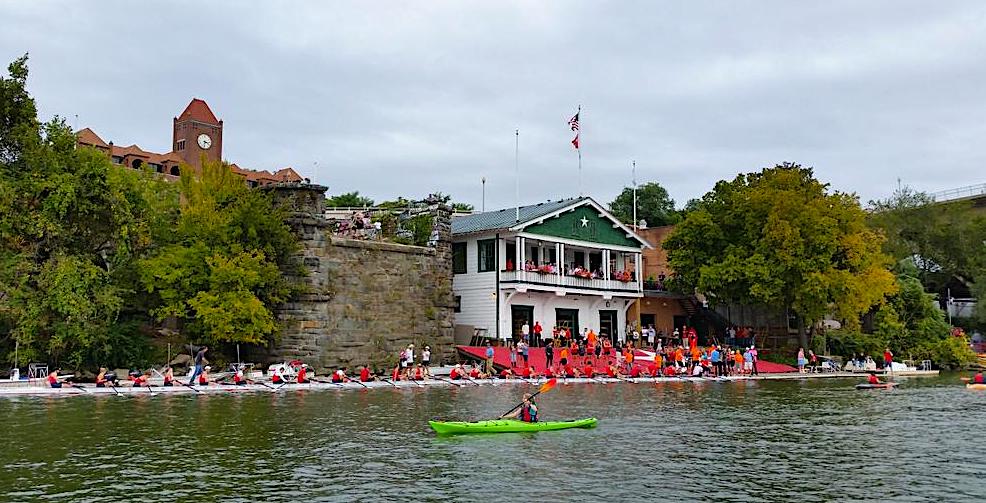
If you saw the pilot of Amazon’s 2018 Jack Ryan series, you might remember the actor John Krasinski playing the titular lead. In the show’s very Georgetowny opening sequence, Ryan begins his morning workout rowing a single scull upstream under Key Bridge, then drops his boat off at the Potomac Boat Club (PBC) before bicycling down busy Washington streets to his job at CIA headquarters in Langley, Virginia. Yes, it’s kind of unrealistic.
However, for those who love the sport of rowing or are newly intrigued by it following this summer’s Tokyo Olympic games, the Potomac Boat Club at 3530 Water St. NW is a gem along the Potomac River in Georgetown and one of only two riverside rowing clubs in Washington, D.C., the other being Thompson Boat Center, just a few docks downstream.
Fall, with its cool breezes, is the perfect time to be out on the water. This weekend, if you’re curious to see crew shells speeding along the river, PBC will be hosting the Charlie Butt Scullers’ Head of the Potomac Regatta from Thompson’s, starting 8 a.m. on Sunday, Sept. 26. The annual regatta is named for Washington-Liberty High School’s famous coach Charlie Butt whose acclaimed crews rowed out of PBC for more than 40 years during his coaching career and still do so today.
Founded in 1869, PBC is the oldest rowing club in the Washington region and, according to the club, “one of the best known in the country.” With “some 300 members, ranging from recreational rowers to Olympic athletes,” the club “hosts several successful competitive programs for scullers [two-oar craft] and sweep rowers [one oar per rower].” PBC has also served as the home of Arlington’s Washington-Liberty High School crew, “one of the first public schools to have a rowing program, dating back 65 years.” Other high school crews in the area row out of Thompson’s, while W-L is PBC’s only high school crew.
As a private, non-profit member-run club for people with some rowing experience, PBC says it “welcomes rowers of all ages and skill levels, sculling and sweep, from novices to juniors to masters, and from the casual to the obsessed! We are a community bound together by our appreciation for this unique institution, our devotion to the sport and our love for the great Potomac River!”
PBC’s elected governing board oversees a variety of volunteer committees. Its Club Rowing group is responsible for all boating activities apart from racing. Participants in the club’s rowing program “comprise a diverse spectrum of PBC members ranging from scullers and sweepers to paddlers; from aspiring to former Olympians; and from highly competitive masters to members simply out on the Potomac for recreation.”
PBC’s Club fleet consists of “12 singles, 9 doubles (5 of which are convertible into pairs) and 3 quads (one of which can be rigged as a straight four) of various weight classes,” complemented by “well over a dozen sets of sculls, 4 sweep oars, and several canoes and paddle boards.”
The PBC Racing Committee oversees the club’s diverse range of men’s, women’s and mixed racing teams from open to masters-level and from singles, to doubles, to quads, to eights. In the fall, PBC hosts the only Head of the Potomac race in Washington.
The Georgetowner ventured to the far west end of Water Street (K Street) to visit the club and speak with its former president and current secretary, Ed Ryan (no relation to the CIA’s Jack Ryan) — a club member for close to 40 years — to find out what the club offers and how it’s fairing these days.
Ryan, who developed a passion for rowing on the Schuylkill while a student at the University of Pennsylvania, keeps his own single at PBC and estimates there might be 40 to 50 private sculls kept by members in the club’s boathouse.
For Ryan, PBC offers not only a great boathouse facility on the Potomac but a sense of camaraderie with other rowers. “First and foremost, it’s a community of fellow rowers,” he said. “There are different levels for rowing here. You can be super competitive and racing all the time or you can do it recreationally just for the exercise and the beauty of being on the river. So, it’s a community of rowers in addition to the greatness of the facility in terms of access to the river, the docks, just the way you can keep your boat here.”
The club’s many social events, from holiday parties to July 4 crab feasts are another huge bonus. “We have a good social committee and everybody likes a good party,” Ryan mused.
But how exclusive is the club? While the waiting list for membership tends to take about two years, Ryan said he’s impressed with how well the club is tackling issues of diversity in the traditionally elite world of club rowing. Over half the governing body and membership is female, he said, pointing to pictures of elected governing board members. The club’s Diversity and Inclusion Committee regularly provides training for club members, handles issues as they arise, and encourages diversification of club membership through scholarships, summer programs, fee and waitlist waivers, and other forms of outreach, especially for younger members.
“I think Black Lives Matter really rang a bell for us — not just for us but for America — and I think we’re doing a nice job of trying to address it,” Ryan said, though the sport of rowing overall continues to be slow to diversify.
As we toured the PBC’s luscious wood-paneled interiors and spacious upper-level veranda with spectacular views of Key Bridge, Rosslyn and the wooded upriver stretches of the Potomac, Ryan spoke with pride about the boat house’s storied history. “The building really is distinctive,” Ryan said. “We’re really proud of it and it’s on the historic register. It was built, I would say, in 1903 more or less, and it looks virtually identical to how it did back then with the exception of an addition that was put on the boat house.”
Though PBC was founded in 1869, its original boat house burned down, replaced by the 1903 structure that stands today. Another boat house near the old Aqueduct, between the Washington Canoe Club and PBC, also burned down but was never rebuilt.
Compared to the Washington Canoe Club next door, PBC appears to be in great physical and structural shape. Ryan attributes this to “really good stewardship of the club that goes back a ways… making sure we always have funds and [thinking] about capital improvements, fixing things before they catastrophically fall apart or break.”
Framed pictures on the walls also tell the stories of the PBC’s many championship coaches, crews and racers. “I’d say the Potomac has had a rower in virtually every Olympics since maybe the ’50s or even before that,” Ryan said. “We have a pretty good pipeline and development program [at PBC] for high-caliber athletes… If you’re in the Olympics you’re rowing generally post-collegiate and you’ve got to put your life on hold to train for the Olympic team.”
Given PBC’s location in a higher-crime area on Water Street beneath the Whitehurst Freeway and next to the remains of the old Aqueduct Bridge, Ryan is optimistic about some of the plans to improve car, pedestrian and bicycle traffic flow and reduce troubles in front of the club’s entrance. “If you had come down here at the end of Water Street about a year or two ago, it was pretty much like Mad Max,” Ryan said. “It was really kind of crazy down here. A lot of people congregate in cars. I’m sure there’s drug traffic… I compliment the D.C. police, however, because I think they do a great job.”
Despite a recent shooting across the street which left “bullet holes in the front door,” Ryan said, “there’s good news on the horizon. The Georgetown BID as well as the ANC and the D.C. Department of Transportation are embarking on …an enlightened project to improve this entire end of the street all the way from 34th Street and all the way to the Capital Crescent Trail. It’s going to be much more pedestrian friendly. It’ll be streetscaped and they’re going to be stopping traffic back at 34th Street with a roundabout so there will be limited access and it will really make this end of Water Street much more pedestrian, visitor and tourist friendly — and safer.” Ryan gives credit to the Georgetown Advisory Neighborhood Commission for listening to the club’s concerns and accommodating its need to have large crew shell trailers and team members moving in and out of the area.
Despite all these challenges, Ryan wouldn’t think of giving up his love of rowing on the Potomac. “I think rowing is one of the best exercises you can get, just aerobically and for your whole body,” he said. “It’s fully body and it doesn’t kill the joints, like running…. It requires skill and, when you’re rowing a single, a lot of balance. And, it’s a sport that rewards technique. So, it’s not necessarily the biggest and brawniest rower that wins the race. It’s most often the rower who’s rowing the best. And, the other part is, you can do it all your life which is really nice. And you have a lot of mutual support and friendship.”

The main room at the Potomac Boat Club. Photo by Chris Jones.

The Potomac Boat Club at 3530 Water (K) Street NW. Photo by Chris Jones.
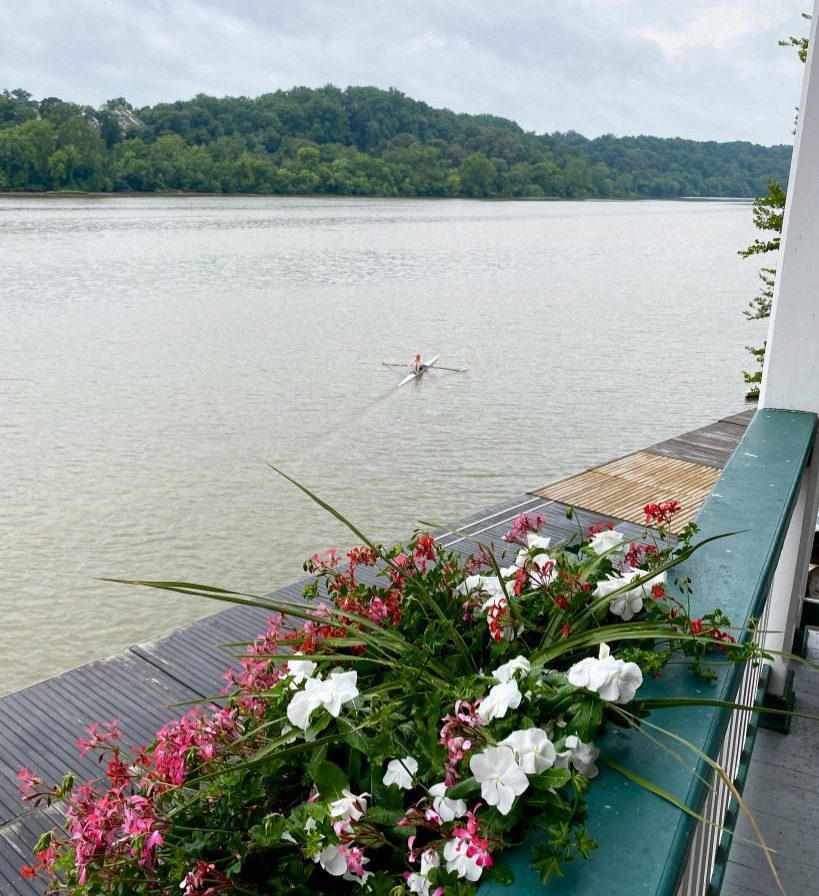
Looking upriver from the Potomac Boat Club. Photo by Chris Jones.
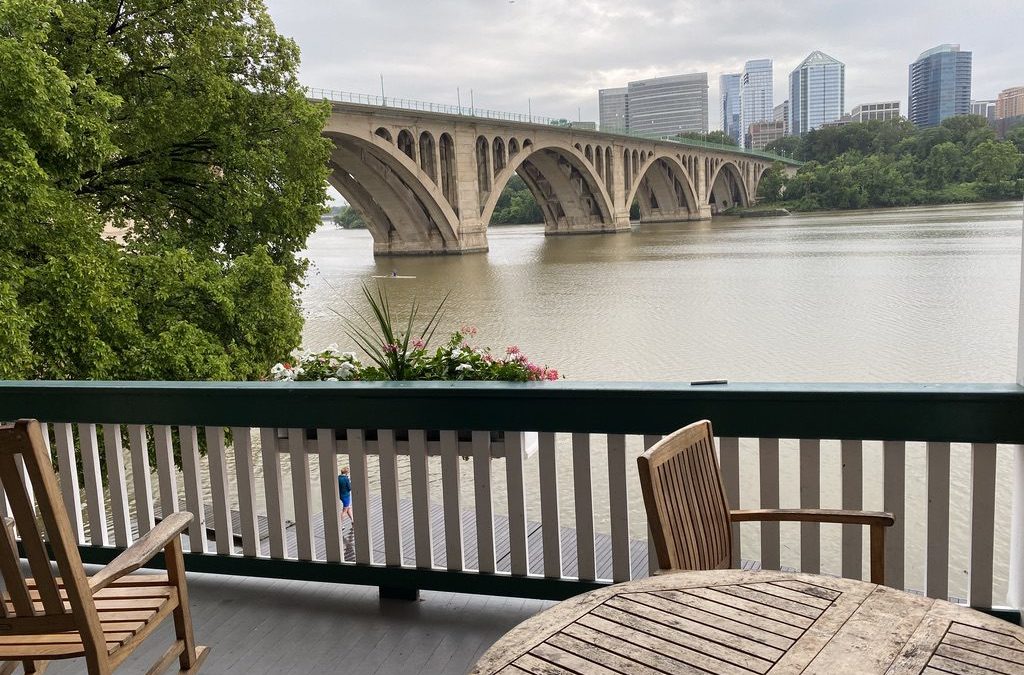
Looking at Key Bridge and Arlington, Virginia, from the Potomac Boat Club. Photo by Chris Jones.
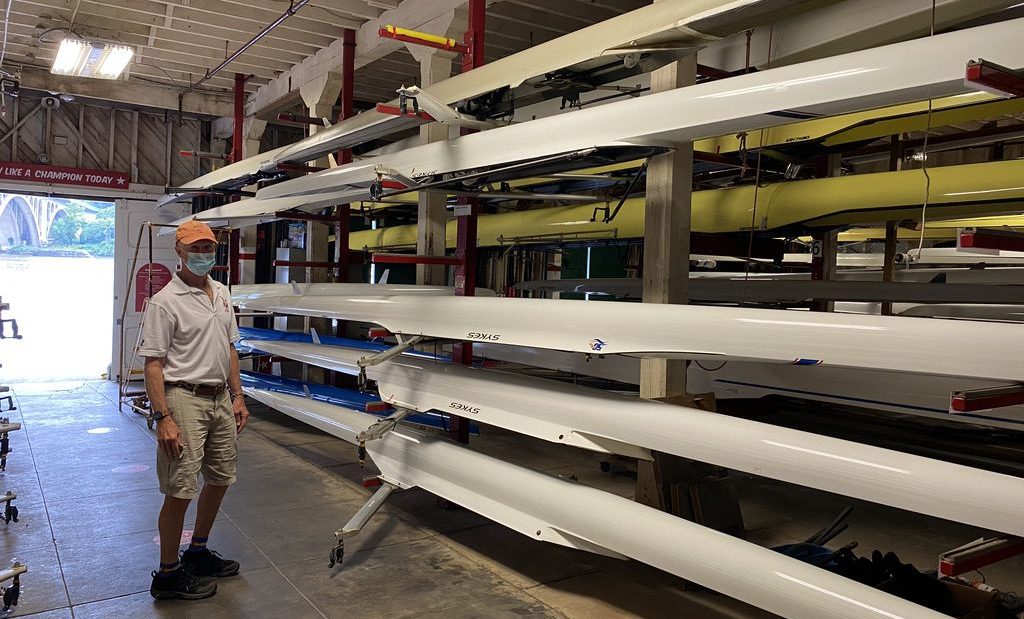
Ed Ryan of the Potomac Boat Club. Photo by Chris Jones.

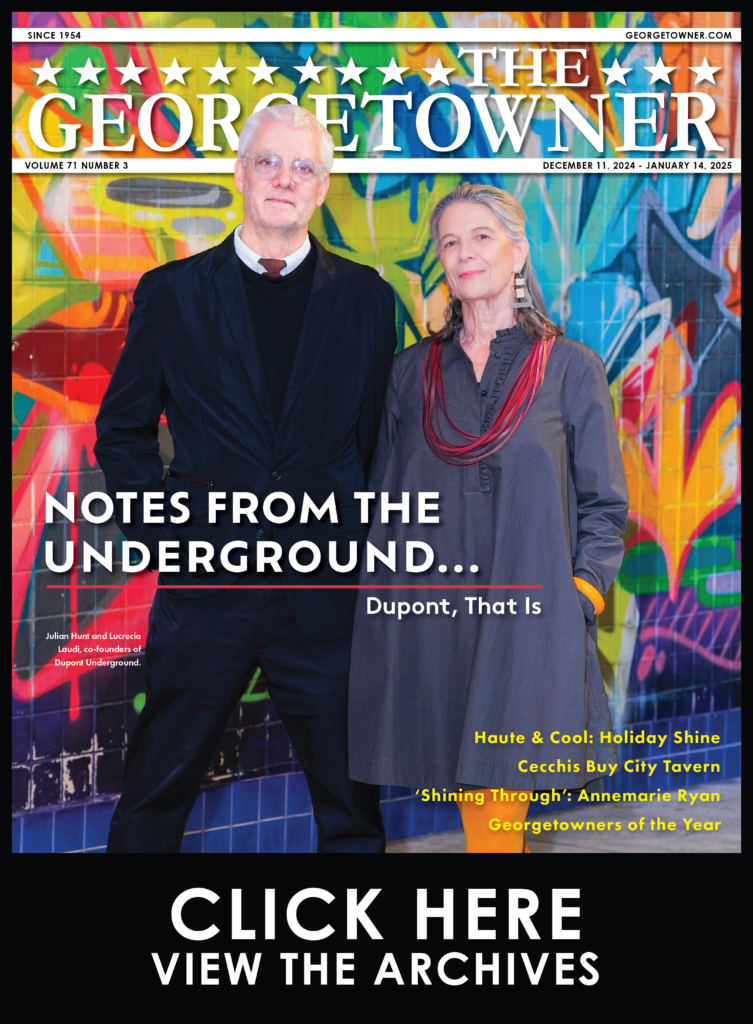
Potomac is elitist. They say they offer these opportunities but most people who try to row there are turned down and are not provided the help that Potomac says they give. Do your research and don’t ask an old white man who has been at the club for 50 years and the only way for someone else to be a member is if he dies.
Response
I joined the club fairly recently. Yes, there’s a waiting list. The club has to limit members for a number of reasons. Otherwise I found them very inclusive. I’m a pretty average rower. They have been welcoming and I made a number of really good friends.
I’m curious about a few points relative to the Potomac Boat Club that were not covered in this article.
Is the boat house and land federally or municipally owned and leased by the Club?
Do they allow the public to visit the site and tour the historic interior?
Do they still require member referrals / recommendations to join the club?
Potomac Boat Club owns the land on which it is located. In this respect it is different from the Washington Canoe Club, which sits on federally owned land. The building has no staff, so it is locked at all times, and we don’t have any program for public tours. But anyone who wishes to see the interior can contact the Club and we would be happy to show you around. I am a member of Potomac Boat Club, and to the best of my knowledge we have never required referrals or recommendations to join the Club. We certainly did not when I joined. As to the commenter who says we are elitist and don’t offer any help to those who wish to row, it is true that we do not have any instructional program in rowing. But Thomson’s Rowing Center does offer such an instructional program. It is also true that we have a waiting list for membership, due to the popularity of rowing, the limited capacity of our building, and the fact that we have agreed with the request by the Georgetown community that we limit our membership. The waiting list is usually about two years, though I’m not sure exactly what it is now. But if you are willing to wait for your time to come up, pretty much anyone can join. I suppose if we discovered someone had a criminal record that threatened the Club or its membership, we might refuse a membership, but I served on the Board for 9 years and cannot remember anyone being denied membership.
A correction: there are three boathouses in DC. The other is the Anacostia Community Boathouse, on the Anacostia River by the Pennsylvania Ave SE bridge. It also hosts club and high school rowing teams as well as paddling groups.
The article discusses the two boathouses in D.C. on the Potomac River. But, thank you for informing our readers of the Anacostia Community Boathouse!